Catalina Sky Survey Tops off 2021 with a Rare Bright Comet Discovery
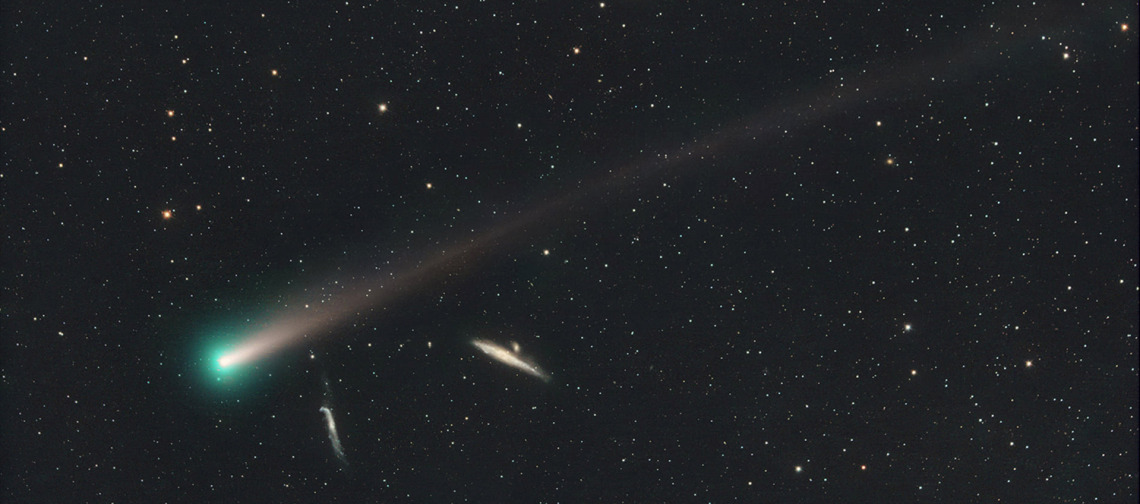
Comet C/2021 A1 Leonard moves past the Whale and Hockey Stick galaxies. November 25, 2021. Image: Michael Jäger.
Telescopes and now binoculars are focusing their views each morning upon a much-anticipated comet that is now entering the inner Solar System and is rapidly brightening. With some luck it may be possible to view the comet with the unaided eye during the middle of December. Introducing comet C/2021 A1 Leonard (aka comet Leonard). The comet was discovered the night of January 3rd of 2021 by CSS observer Greg Leonard with the 1.5m reflector atop of Mt. Lemmon, Arizona. This was the first comet discovered in 2021, and it was thus designated C/2021 A1 (Leonard). At the time of discovery, the comet was 400,000 times dimmer than what the human eye can see and was detected as a fuzzy patch of pixels tracking across the background stars in four telescope images. In the past, comets were discovered visually by very dedicated astronomers who spent countless hours scanning the night skies with a telescope. In recent decades, most comets are discovered incidentally by surveys tasked with finding near-Earth asteroids like the NASA-funded Catalina Sky Survey (CSS), Pan-STARRS, ATLAS and NEOWISE projects.
Comets are small bodies of the Solar System which are largely comprised of different types of ices and dust. Most comets have undergone very little processing since the beginning of the Solar System since they spend most of their lifetime at large heliocentric distances in the most frigid regions of space. Cometary nuclei therefore contain pristine samples of grains and gas from the protosolar nebula in which they formed; thus studying comets allows us to peek into the early conditions of our Solar System’s formation.
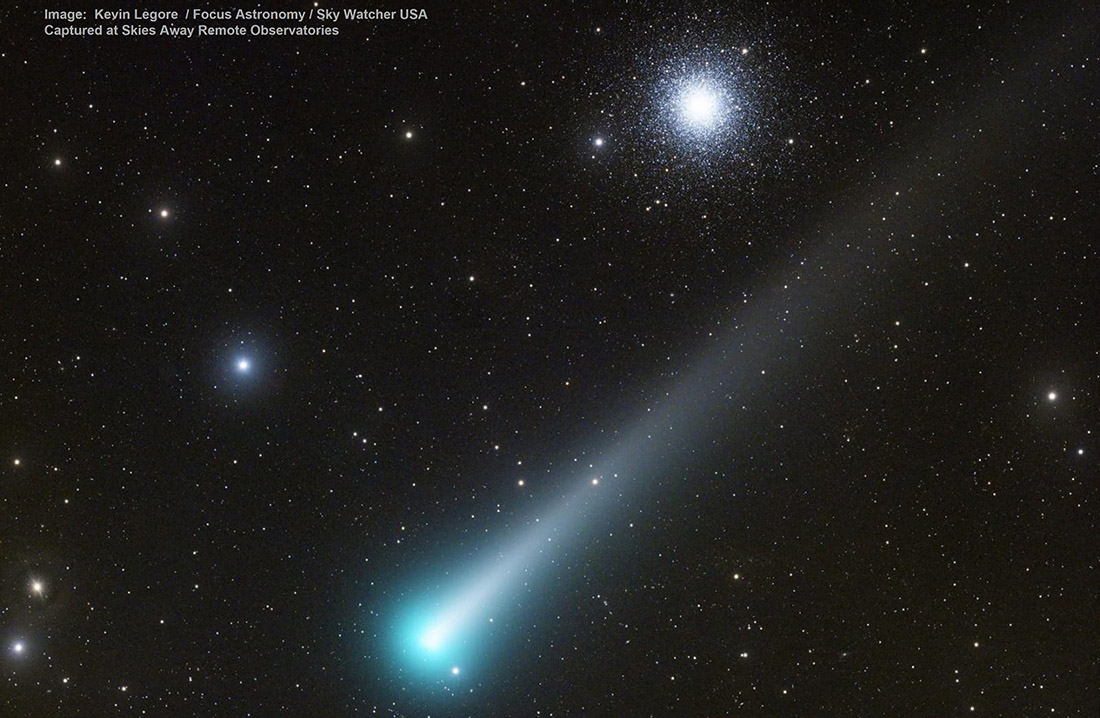
Comet C/2021 A1 (Leonard) passing by Messier 3 a globular star cluster in Canes Venatici. Image: Kevin Legore / Focus Astronomy / Sky Watcher USA. Captured at Skies Away Remote Observatories.
The most abundant ice and contributor to cometary activity through sublimation is water-ice, but upon discovery, C/2021 A1(Leonard) was observed to be active beyond the water-ice sublimation zone. This means that other mechanisms different from water-ice sublimation were responsible for the activity, possibly through the sublimation of other icy compounds such as carbon monoxide, carbon dioxide, or different exothermic mechanisms.
This comet will reach its closest approach to the sun (perihelion) on January 3rd 2022 but perhaps the best date to observe it from the Northern hemisphere will be December 12th, which coincides with its closest approach to Earth. During this time comet Leonard will be a challenging object to view as it hovers low above the west-southwest horizon just after the sun sets. However, we expect an enhancement in cometary brightness caused by forward scattering of sunlight as it passes through the dusty tail, producing what will most certainly be a fine telescopic, binocular or even naked-eye object. The subsequent evenings of December 13-17 should also be worth a look. Before that time, from around December 5 – 10, the comet is in the early morning eastern sky and can best be viewed with binoculars and telescopes, preferably away from bright urban lights.
Comet C/2021 A1 (Leonard) orbit diagram. (Click image for interactive orbit plot)
Let´s hear what the discoverer of the comet, Greg Leonard himself has to say about comet C/2021 A1 (Leonard), and about his background leading up to discovery (questions by Kacper Wierzchos).
KW: Greg, you discovered comet C/2021 A1 (Leonard) earlier this year, but I'm sure that it has been a long road to get where you are. Can you describe your first encounter with astronomy?
GL: I recall sometime in 1979 one of my uncles showed me Saturn through a small telescope. I was absolutely mesmerized by that little ringed world as it appeared so perfect and pristine suspended in the eyepiece of the telescope. That year for Christmas my parents gifted me a 3-inch Edmund Scientific Newtonian telescope and I started exploring the cosmos from my backyard, fumbling my way through the murky skies of Philadelphia. The next year 1980, the original Cosmos series appeared on public television and Carl Sagan became my guide, companion and my further inspiration into astronomy and the mysterious workings of the universe. I’ve been observing the night skies ever since.
KW: In some ways, many of us who know you think of you as a modern-day Indiana Jones. You have been in a lot of countries and had quite a few adventures as a field geologist. Can you tell us a bit about your previous endeavors as a field geologist?
GL: Actually, one of my first experiences after getting my BSc in geology was working at the Branch of Astrogeology at the U.S. Geological Survey in Flagstaff, Arizona. I worked with Gene and Carolyn Shoemaker at the Palomar Asteroid and Comet Survey and also did some geologic mapping of Mars. As funding ran out, I decided to work in the mineral exploration industry, partly because there was some immediate work available, and partly because I was a young geologist and realized I wanted to see more rocks where they live, in the field. I also appreciated that Gene Shoemaker had spent time as a mineral exploration geologist in his early career. So over the next 15 years I worked across the southwestern US, spent several years in the jungles of Indonesia, and many years still in the beautiful voids of Outer Mongolia. I primarily explored for gold and copper deposits. During that period my wife Barbara and I also traveled to adventured in many countries.
After leaving industry, my career took another whimsical turn. My earth-science field resume and remote sensing skills landed me a research position studying alpine glaciers, particularly their response to climate change. I assisted with remote sensing measurements and analyses of glacier changes, did field mapping of glacier terrains in Alaska and conducted bathymetric surveys on high altitude lakes in the Nepal Himalaya. Basically, we were documenting the rapid diminishment of alpine glaciers across the planet and monitoring the mountain hazards associated with fast-melting glaciers. One of the milestone achievements of this work was the publication of the book ‘Global Land Ice Measurements from Space’ for which I’m an editor and co-author.
However, through much of my time as a field geologist and glaciologist, I never strayed far from planetary science and I continued working on the odd planetary project with my former colleagues at the USGS and folks at the Planetary Science Institute; I’m still involved with planetary geologic mapping projects today. In 2014, I even participated on an astronaut analog project as the Commander of Mission 144 at the Mars Society's Mars Desert Research Station in southern Utah.
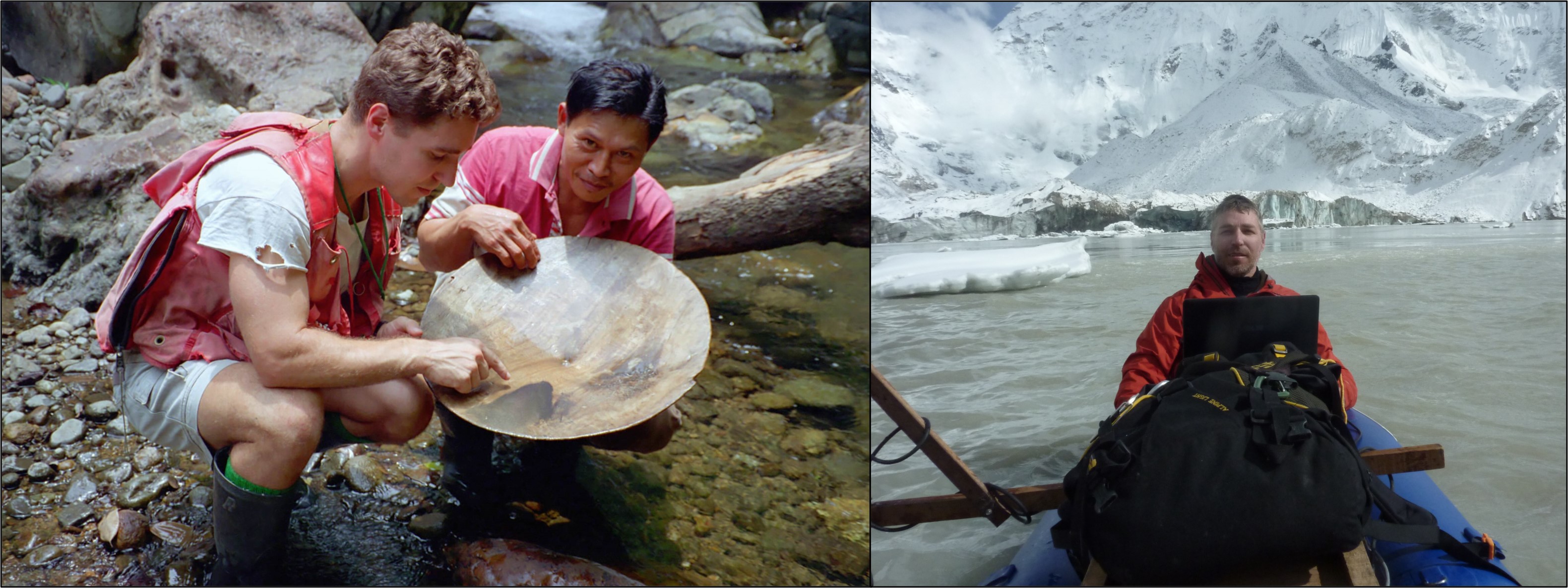
Leonard (L) exploring for gold in the jungles of Indonesia, and (R) conducting a UNDP bathymetric survey of Imja Lake, Nepal. Images: G Leonard.
KW: Any remarkable stories?
GL: The adventures, and mis-adventures are really too numerous to elaborate upon. I saw and experienced many wondrous, wacky, and mysterious things, and I finally saw a lot of rocks, and ice too.
KW: In the early 90s you had the privilege of working alongside Eugene and Carolyn Shoemaker in their survey at Palomar. Other collaborators in the group included David Levy and Henry Holt. Can you tell us about your experience working with the Shoemakers?
GL: I had earned a post-graduate USGS summer internship that allowed me to go to any USGS facility in the country for summer work. I wasn’t sure where I wanted to go until I recalled seeing Gene Shoemaker on a documentary where he was discussing the exotic geology of Jupiter’s moons and Miranda, the chaotically-jumbled moon of Uranus. It was captivating and I was astonished that Gene was a geologist --a USGS geologist who studies planets! So, I cold-called him, apparently got him out of a tedious meeting, and since I was already funded, he encouraged me to come to Flagstaff. I worked with Gene and Carolyn Shoemaker, David Levy, and Henry Holt at the Palomar Asteroid and Comet Survey for the summer and into the Fall and Winter.
KW: What did a typical observing night look like?
GL: We would wake up mid-afternoon, eat breakfast and head to the observatory a couple hours before sunset. Since we were still using film (Kodak Tech Pan 4415) we would start hypersensitizing some films which involved baking them while passing nitrogen forming-gas through them. This would greatly increase the sensitivity and therefore speed of the film. There were several other key duties that would be divided up among the three or four of us there at the observatory. In the darkroom film sheets had to be cut into 6-inch diameter rounds; and individual round films were then placed into a custom plate holder that was then mounted inside the Schmidt telescope before each new exposure. Exposed films had to be developed in the darkroom and hung to dry before film pairs were scanned in a stereo-microscope for potentially new objects. Up on the telescope deck, one observer would guide the telescope for the 4-5 minute exposures using a finder-scope and remote-control paddle to correct for any drifting of the telescope. Another person would time the exposures, call out the coordinates for the next field, and describe the magnitude of the next guide star. Carolyn typically did all the scanning and would mark down positions of objects requiring positional measurement. Occasionally if a newly discovered object were of high interest measurements could be obtained using an old measuring engine located at the Palomar 48-inch telescope. Otherwise the films would be marked for objects of interest and brought back to Flagstaff where I would measure their positions using Lowell Observatory’s photomicro-densitometer machine. We would swap out on many of these tasks, and it would be non-stop from sunset to sunrise every night. Telescope time is precious, and all of us believed that we were always one image pair away from an interesting discovery.
KW: What do you most remember during those nights at Palomar?
GL: It was fun being at the telescope in the open air of the dome, under a starry sky, working as a team trying to discover new worlds. I believe that the promise of discovery was always lurking in our minds and hearts; and knowing too that we were doing something meaningful and having fun doing it is what made this experience so special. There was great camaraderie during observing runs; we all believed this was the best work on the planet, and it was.
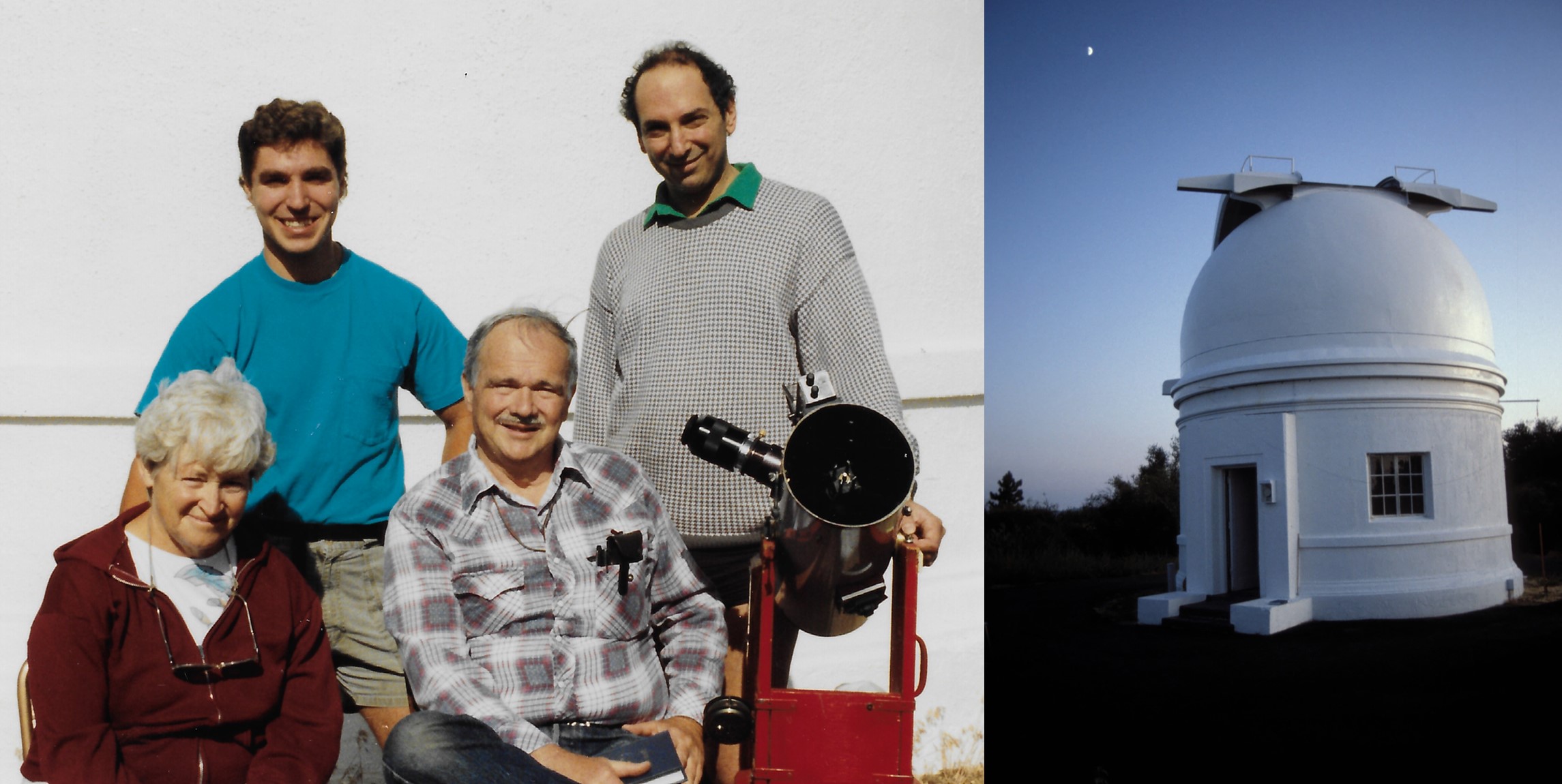
At the Palomar Schmidt Telescope. Gene and Carolyn Shoemaker (seated), David Levy, Greg Leonard. Image : G Leonard.
KW: At CSS we have people that come from a wide range of backgrounds (computer science, engineering, astronomy, data science, geology, etc.). How did you end up working for CSS? Did you know about CSS before applying to the job?
GL: After working at Palomar, I kept up on the progress of near-Earth object (NEO) surveys. I had heard about the Catalina Sky Survey starting up in the late 1990s, and in fact as an undergraduate, I had some overlap at the University of Arizona with CSS co-founders Carl Hergenrother and Tim Spahr (then known as the Bigelow Sky Survey, initiated by Steve Larson). I was excited to hear about their new project. So, I followed the rise of BSS/CSS from early on, and the other emerging electro-optical projects of the late 1990’s like LINEAR and NEAT. Sometime around 2011 or 2012 I bumped into CSS astronomer Rik Hill at the Tucson Gem and Mineral show, in a meteorite dealer’s exhibit of course. He encouraged me to apply for a CSS observer position. A few short years later I decided to return to my beginnings, back to astronomy and planetary sciences. I knocked on the door of CSS director Eric Christensen and formally applied for a position shortly thereafter. Interestingly I ended up filling the observer’s position vacated by the retiring Rik Hill.
KW: As part of the night crew, you are responsible for conducting survey and/or follow-up operations at night. What is the aspect of working at CSS that you enjoy the most?
GL: I like almost everything about being a full-time CSS observer. I love our mission to discover and track near-Earth objects; I like the idea that we are keeping vigil for the Earth. I enjoy working atop remote mountaintops, waking up in the afternoons and having the southern Arizona landscape at my feet. Our workplace is spectacular; I enjoy exploring the forests and geology in the afternoon, and the starry skies by night. And perhaps most of all there’s always the promise of new and novel discoveries, night after night.
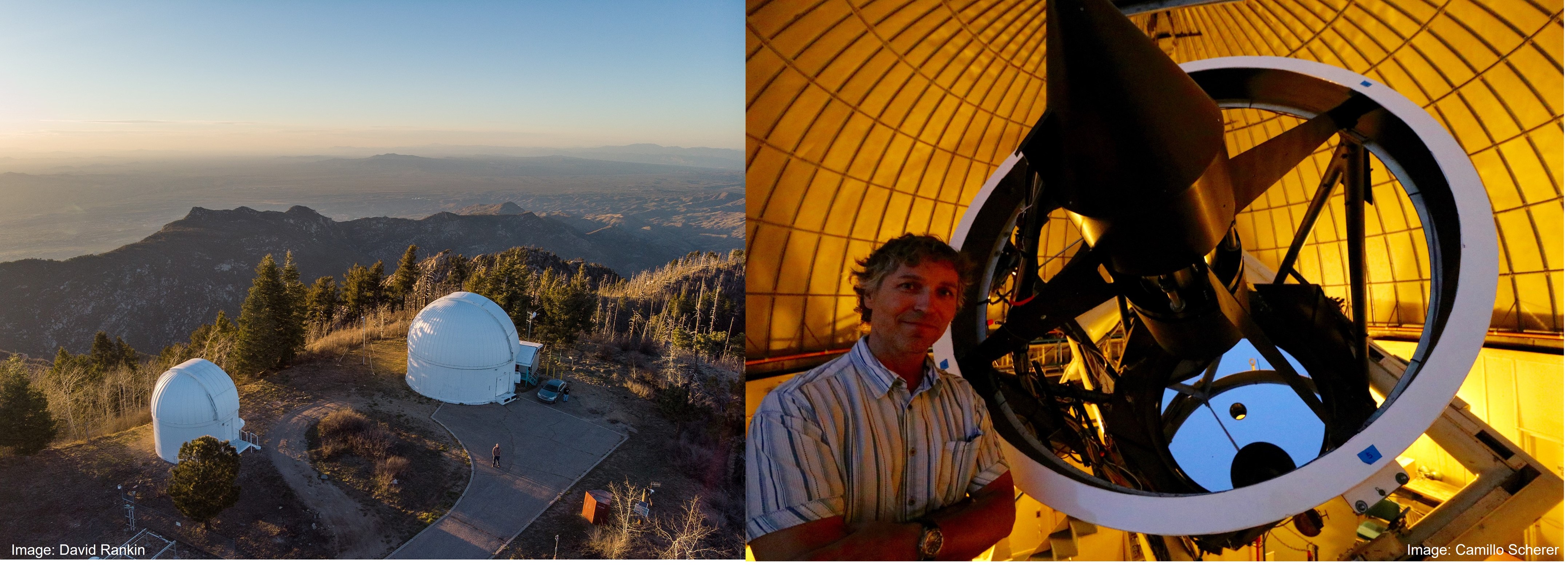
Catalina Sky Survey 1m and 1.5m telescope domes atop the Santa Catalina Mts (Credit D. Rankin). Leonard at the top end of the CSS's 1.5m reflector telescope (Credit C. Scherer).
KW: When I had the pleasure of training with you at CSS, I remember that you would get exceedingly excited every time we found a NEO. You even gave me the high five for each NEO that we found. Do you still feel the thrill of discovery when an unknown object appears on the screen? What do you consider your most important discovery?
GL: It’s always a thrill to see a potentially new world, albeit perhaps a small asteroid world for the first time. I also never take it for granted that my discovery rests on the giant shoulders of our project software engineers, hardware and optical experts, and the mountain operations team that keep the telescopes and mountain sites humming along. That said from a mission standpoint our most important discoveries are near-Earth asteroids deemed ‘potentially hazardous asteroids’ (PHAs). These are asteroids that exceed both thresholds of size (larger than 140m across) and orbital proximity to earth (closer than about 20 earth-moon distances). These are the asteroids we need to discover and keep close track of since they are among the most likely objects to impact earth, over deep time of course, typically over many 1000s to millions of years. So in addition to having discovered over 50 PHAs, I’ve discovered over 1500 near-Earth asteroids (NEAs) which is > 5% of all known NEAs. I’ve also discovered one near-Earth comet which I count as a favorite discovery since it’s a near earth object and, well another comet! It was discovered during Christmas night which also makes it special to me.
KW: In the Fall of 2017, you became a comet discoverer after finding comet C/2017 W2 (Leonard), a Halley-type comet no less. Do you remember that night? Was it special for you?
GL: I sure do remember, and it was special. Many CSS observers have discovered numerous comets over the years, and after about a year-and-a-half on the project I was beginning to wonder if I would ever discover one as well. So finally one late November morning I observed an object tracking across my computer screen…and it has a tail… and better yet, a search of the databases shows no known object in that orbit. I went through the requisite procedures to formally submit it, and then I didn’t sleep that day (and for a few days), waiting, waiting, waiting for confirmation of my new discovery, which eventually came. I was ecstatic.
KW: When we discover comets, they usually appear as very faint and fuzzy objects, and we have no way of telling whether it will become an interesting object or not. In the case of C/2021 A1 (Leonard) it certainly looks like it will become an interesting comet. Do you recall anything in particular about the night of the discovery of C/2021 A1 (Leonard)?
GL: It was an early Sunday morning discovery. I recall being on a family zoom meeting the previous evening, and everybody loved seeing the control room monitors as my zoom backdrop. My wife and family wished me luck for the night before signing off, and so when I saw the comet on the screen in the morning, I felt that they were in some way a part of the discovery. There’s also something quite special about beginning the new year with a new comet discovery and having the first comet discovery of the year (C/2021 A1). That alone would have been enough.

Comet C/2021 A1 (Leonard), animated discovery images. Images: G. Leonard.
KW: 2020 was a year filled with unknowns, but millions of people looked at the sky and found a moment of awe and peace seeing comet C/2020 F8 (NEOWISE). Now your comet has the potential to be a good binocular or even naked-eye object. How does that make you feel?
GL: Well, I’m really excited like everyone else; and with my name attached to it, I am very, very, humbled. Discovering a comet is enough for anyone but discovering a potentially naked eye comet is something that any astronomer worth their weight in eyepieces only dreams about. Also, I do appreciate that the mere presence of this comet, or any comet, offers an opportunity to be humbled; it’s a reminder of the beauty, the mystery, and the possible menace of the cosmos. It's something we have no control over.
KW: I see a lot of young people in social media, forums and mailing lists that are very interested in comets, many of them dream about discovering a comet one day. What advice do you have for them?
GL: The great thing about comets and astronomy in general is that it can be enjoyed at every level: from the casual backyard observer to the dedicated amateur astro-photographers and photometrists, to the professional research astronomers and planetary experts who make it a career. In my view, the most successful astronomers and observers are those that are having the most fun.
I recall some words of inspiration imparted to me by Gene Shoemaker. As a young geologist, with funding running out, I was very unsure of my career path. Among other words of encouragement, he said to me ‘…remember, something is discovered for the first time only once’. I realize now that those words have acted somewhat of as a mantra for all my professional life in that I’ve endeavored to seek out experiences that allow for adventure, exploration, and discovery. It’s really that simple, making choices that can lead to these things.
Perhaps to end on some pragmatic advice I would say this, knock on doors. Go and knock on the door of someone you admire, someone you want to learn from, work with, or emulate. This might be a teacher, a researcher, a farmer, a builder, an explorer, whoever. Ask them how you might get involved with helping them, and if they allow for that, then listen, learn, and get to work.
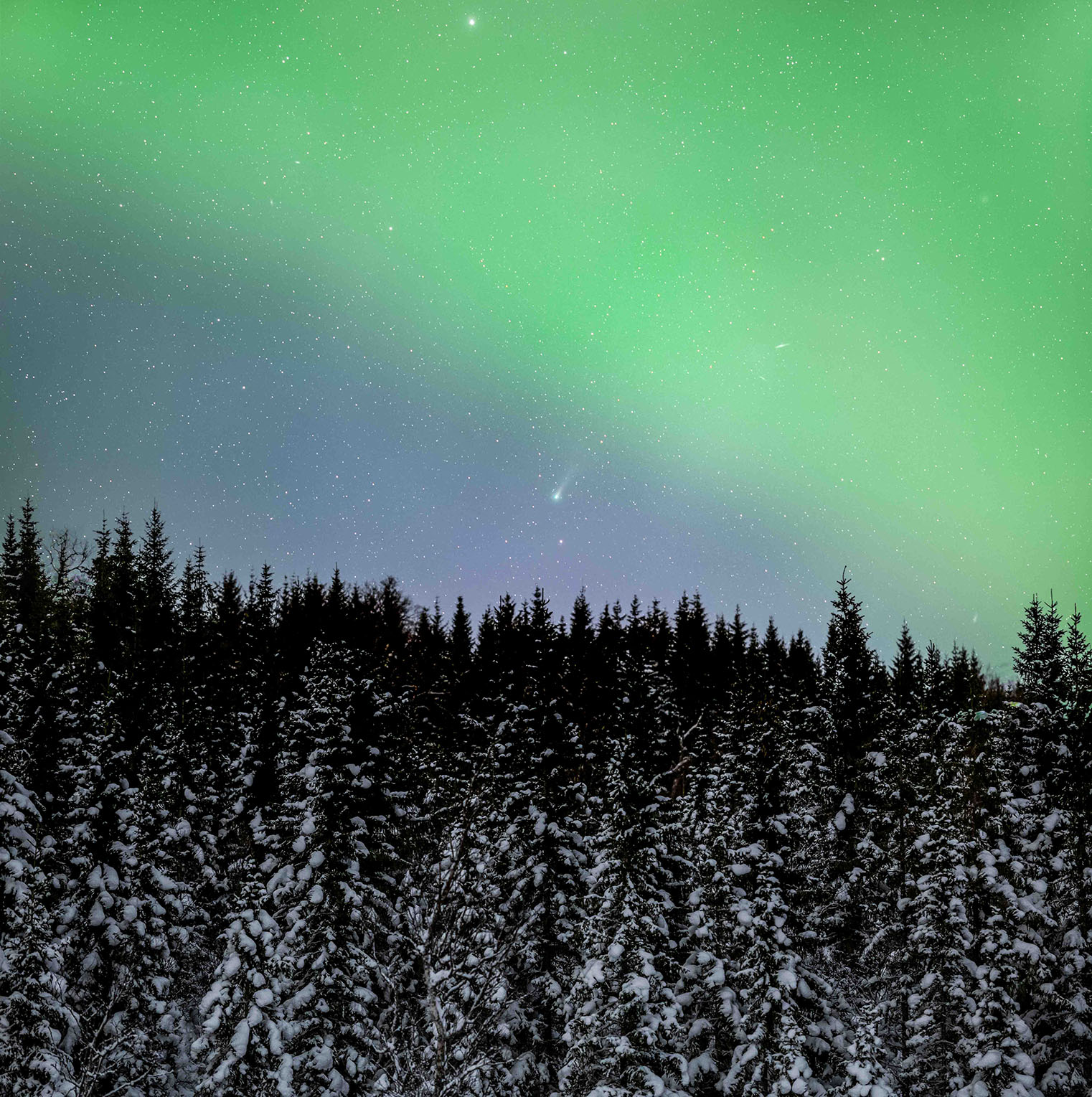
Comet C/2021 A1 (Leonard) with green aurora, Norway. Image: Adrien Mauduit & Night Lights Films
The Catalina Sky Survey is based at the Lunar and Planetary Laboratory in the University of Arizona’s Planetary Science Department. CSS is a NASA funded project whose dedicated mission is to discover and track near-Earth objects.




